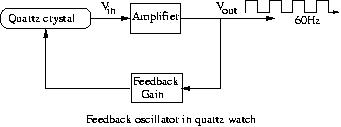
Short answer: In wristwatches, the oscillators used to generate the timing signal (that correctly counts out the seconds, minutes and hours) are set up as feedback loops.
Long answer: At the heart of a watch is a device that can generate an accurate 60Hz signal. The 60Hz signal is divided down using a counter to generate a 1Hz signal. In digital watches, this signal is used to produce the hours, minutes and seconds counts that make up the time display (see here for details on this). In watches with hands, the 1Hz signal is used to drive a tiny electric motor which is connected to a gearing system that drive the hands.
In battery operated wristwatches, this 60Hz signal is generated using a quartz crystal oscillator. The crystal is made from thin sheets of quartz plated like an integrated circuit and etched chemically to the shape of a tiny bar or a tuning fork. It turns out that quartz has a special property (Piezoelectric effect) as a result of which when compressed or bent, it generates a charge or a voltage on its surface. Similarly, if a voltage is applied, quartz will bend or change its shape very slightly. Sustainable oscillations are generated by embedding the crystal in a feedback loop as follows. The surface voltage on the crystal is picked off with plated electrodes, amplified by a transistor or integrated circuit, and re-applied to the crystal to keep it oscillating (bending and straightening). See figure below. The cycle is set into motion initially by the electronics amplifying noise at the crstal frequency. This then regenerates into an oscillation through feedback. The frequency of the oscillation depends on the precision in the manufacture of the crystal, its quality, etc.

References: